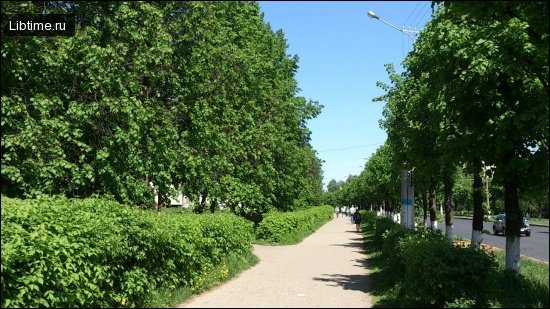Requirements for the design of greening of residential areas
The planning of greenery facilities in residential areas and neighborhoods is determined by urban planning requirements. The most important of them are:
- sanitary and hygienic
- socio-economic;
- architectural and planning.

- Normal sun exposure (insolation) of buildings and lighting of rooms for at least 2-3 hours per day between March 22 and September 22 in areas located south of 60°N and between April 22 and August 22 - north of 60°N, as well as exposure of the area between buildings;
- normal air exchange in the territory of residential buildings, which ensures good ventilation; in areas with strong winds, it is necessary to slow down the wind flow by a system of special measures.
Solar irradiation and wind conditions are determined by the natural and climatic factors of the area. In the CIS countries, climatic zoning was carried out specifically for construction, according to which the entire territory of the country is divided into four construction and climatic regions.
Each of these areas, in turn, is divided into sub-areas characterized by their own conditions. The data in Table 1 can be taken into account when designing landscaping.
Solar irradiation, or insolation, plays a very large and vital role. The effect of direct sunlight is known. It kills pathogenic bacteria and makes the environment in which a person is located healthier.
Insolation has thermal, light and biophysical effects on the human body. Excessive insolation leads to overheating of surfaces, worsening the human environment. The temperature comfort range of the environment is +16 - +24 °C. In order to obtain the optimal level of insolation, it is necessary to comply with the requirements of the correct orientation of buildings.
In the middle zone and in the north of the former USSR, buildings should be located from south to north (along the meridian) with a deviation from this direction to the west or east of no more than 45°. In the south, in the Transcaucasus and Central Asia, latitudinal orientation (i.e., east-west) is common, with a deviation of the long axis of the building to the east of 30°.
In the southern regions, the most favorable is the western direction. The gentle western rays of the sun penetrate deeply into the apartments, which heat up during the day and cause overheating. The southern orientation is more favorable because the sun is high in the south and the rays do not enter the apartments.
To ensure optimal insolation of buildings, sanitary gaps were developed. These gaps should allow sunlight to enter the windows of ground floor buildings and prevent them from being shaded by other buildings.
Sanitary breaks are assigned according to the height of the building. They are used for plantings, areas for recreation and physical education, economic and household activities.
Table 1 - Total building height, m, depending on the number of storeys.
| Number of floors | Total building height |
|---|---|
| 5 | 15 |
| 9 | 27 |
| 10 | 30 |
| 12 | 36 |
| 14 | 42 |
| 16 | 48 |
| 17 | 51 |
| 22 | 60 |
In the case of latitudinal arrangement of buildings, the distances between them are determined by the height of the building on the south side. In areas where there is little sun, the gaps can be increased, and where there is a lot of sun, it is permissible to reduce them. 
Household plots and gardens of residential groups with a set of playgrounds should be accessible to sunlight throughout the year. At the same time, in hot summertime, it is necessary to provide shading for individual areas.
The desired effect can be obtained by planting trees with a dense crown or with the help of various structures - canopies, walls, pergolas, etc. When designing landscaping for a residential area, it is important to take into account its illumination and shading during the day, as well as in the warm season, in order to choose the right range of plants. To this end, an insolation schedule is drawn up for the territory using special insolation rulers (light meters).
The most promising way to calculate the insolation of a building is on a computer. The calculation of direct solar radiation (insolation) is carried out on the basis of the Methodological Recommendations for ensuring normative insolation in the premises of residential and public buildings and on the territory of the development.
The thermal regime is determined by the total solar radiation and air temperature and is calculated in various ways [drawing insolation duration indicators on the plan, determining the amount of thermal energy using tables, drawing isolines in multiples of 1000 kcal/(m2 - day)].
An important factor is the wind regime. In areas where there are many windless, calm days, it is necessary to ensure that the territory is ventilated. This is achieved by a certain arrangement of buildings that takes into account the main directions of air flow.
Typically, enclosed courtyards create air stagnation. On the contrary, buildings located "in line", linearly along the direction of air movement, create favorable conditions for ventilation of the territories. It is important to take into account the prevailing wind direction in the area.
Data on wind directions are taken from meteorological stations: the so-called wind rose for these conditions is taken into account. (Wind roses are compiled according to meteorological stations, which are measured at a weather vane height of 10-15 m, and the aeration regime of the building is formed in a layer uninhabited by humans, at a height of 2 m).
It is possible to analyze the aeration of the residential area, taking into account the distribution of winds in the warm and cold seasons. With the chosen building composition, intra-quarter areas are more effectively protected from northwesterly winds.
This arrangement of buildings is justified if the speed of summer winds is high and winter winds are low. In areas with strong winds, buildings should be compact and closed.
To protect against the wind, protective strips of plantings, special screen houses with one side facing the prevailing winds can be used. There are many options for protecting residential buildings from both strong winds and noise from highways at the same time. Such solutions help to optimize the hygiene regime in the living environment.
Economic requirements
The main economic indicator is building density and population. The size of buildings, their capacity, number of storeys, density of location on the allocated area, and population are also of great importance.
When developing a landscaping project for a residential area, it is also necessary to calculate individual elements of the territory - areas for various purposes, paths, planting areas. It is necessary to take into account the number of people living in the neighborhood and the area of the territory occupied by the building.
The building density of a neighborhood is the percentage of the area occupied by buildings and structures to the total area of the neighborhood. Building density depends on the number of storeys of buildings. As the number of storeys increases, the building density decreases, which means that the amount of undeveloped land is freed up for landscaping.
For example, when a neighborhood is built up with 5-storey buildings, the density is 20%, and with 9-storey buildings - 17%. In arid and mountainous areas, the building density can be increased.
The population density of a neighborhood is the number of residents per 1 hectare of the residential part of the neighborhood. Based on the settlement rate of 9m2 per 1 person, the housing density indicator is introduced, which is determined by the total amount of living space per 1 hectare of the residential part of the neighborhood.
The higher the number of storeys, the more living space there is in the neighborhood. For example, in a 5-storey building, the housing stock area is 4800m2/ha, and in a 9-storey building, it is 6300m2/ha. With mixed development, the density of the housing stock can be increased to 6500-7500m2/ha.
Knowing the density of the housing stock and the average settlement rate, it is possible to determine the population density of the neighborhood n=P/p, persons/ha where n is the population density; P is the density of the housing stock; p is the average settlement rate.
Depending on the number of people, number of storeys and the estimated density of the housing stock, the size of the neighborhood can vary between 10-25 hectares. Having determined the estimated indicators of residential development - population density, building density and housing stock - it is possible to calculate the area of individual elements of the microdistrict.
The specific dimensions of individual elements of the territory per person and the total area of green spaces, buildings and other elements of improvement are calculated.
Architectural and planning requirements play a decisive role in the choice of a particular method of greening residential development. The location of buildings and structures, underground utilities, pedestrian routes in the neighborhood, taking into account the public service system, sanitary and economic conditions and requirements, determines the nature of the landscaping.
The spatial arrangement of buildings and structures themselves also has a significant impact on the choice of a planning solution for the residential area of a neighborhood. It depends on a number of factors, including the urban planning situation, the topography of the territory, and the presence of existing plantings (arrays, groves, tapeworms).
Methods of building placement
Perimeter - development with the placement of buildings along the red lines of streets or highways that are the boundaries of the neighborhood (in the form of a square or rectangle). This technique is used in flat areas.
The placement of buildings is strictly regular and leads to the formation of enclosed spaces, inside which schools, kindergartens, green courtyards for recreation and economic activities of the population are designed. 
This method of placement is characteristic of large residential areas located on rough terrain with the presence of plantations and reservoirs.
Courtyards-gardens include a set of planning elements for the daily servicing of the population and are solved as compact green formations, connected to each other and the garden of the neighborhood by pedestrian routes and through the plantings of streets and boulevards - with the garden or park of the residential area.
Row buildings are characterized by having parallel rows of houses (or arranged in a "line") regardless of the direction of the streets. Row buildings have advantages in terms of insolation of buildings, aeration of space, especially in unfavorable climate conditions.
With this type of development, plantings are placed in front gardens or adjacent strips, between residential buildings in the form of courtyards with recreation areas. Curtains and groups of trees and shrubs are concentrated near the sites. The presence of open areas in the form of lawn areas stretched in the direction of air movement is mandatory.
Combined development is now the most widespread. It is characterized by a combination of these techniques. This type of development allows to diversify the planning solution of landscaping, to take into account the features of the landscape as much as possible - relief, vegetation, water bodies, to create favorable conditions for life and recreation of the population.
In the case of a combined type of development, landscaping is based on the principles of landscape composition, taking into account the peculiarities of the area by creating both courtyard gardens for groups of residential buildings and a common neighborhood garden. The plantings are formed in the form of groups or small clumps on the lawn using a rich palette of tree and shrub plants.
In green areas, all buildings and sites are placed freely, taking into account the maximum accessibility and convenience for the movement of residents. Of great importance is the creation of unified walking and transit routes that combine courtyard gardens with the neighborhood garden.


